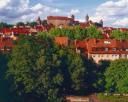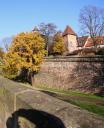I love Nuremberg. I do love Nuremberg. Though it has been voted to be the most boring city in Germany by Spiegel magazine several years ago. The author just has to have had made a mistake. Nuremberg is one of the most exciting, yet unboastful city with a lively and vibrant subculture, it even has a bigger alternative and autonomous scene than posh and tidy Munich, and of course, culturally hip Edinburgh. Maybe the poll editor just looked in the wrong places and looked for trendy, upper class clubs and discotheques of which they are few?
The trick is that Nuremberg lies very close to two other major cities: Erlangen, where most of the shared university is located, and Fuerth, which is best known for its industry.
The city is still known best for three things: The International Nuremberg Trial against the Nazi leadership, the Nazi Party Rallies and the Christmas market. The Tourist Office mainly promotes visiting the Castle, the churches, the museums, the Albrecht Duerer House, the half-timbered medieval buildings in the old town, the historic dungeons below the city hall and the passageways in the rocks underneath the castle.
There are about forty museums in and around Nuremberg. Recently opened the New Museum for modern art and the Documentation Centre Nazi Party Rally Grounds in 2003. Apart from the tram museum, there is also astonishingly a pigeon, a pacifism, a garden shed, a bible, a radio, a Red Cross and a dialysis museum.
In the surrounding countryside, there is even a Horseradish Museum, an 16km archaeological four hours walkway near Hiltpoltstein and an architectural outdoors museum, to which all old historical buildings were relocated stone by stone when grounds were cleared for huge development projects.
People in Nuremberg are constantly in motion, physically and intellectually and socially. That might be the influence of the city’s location at main motorways and railway lines to Berlin, Munich, Frankfurt, Stuttgart and Prague.
Every time I return to Nuremberg for a short holiday, I feel recharged with activity and plans and ideas for new projects. The vibrancy, curiosity and drive to travel, learn and gather experiences give the locals a reputation for being largely tolerant but relatively guarded, following mainly the slogan:“Live and let live”.
But once the initial caution is overcome, there is no stopping of the enthusiasm, heartfelt warmness and friendliness of the locals.
The city is the second major city with 500 000 inhabitants located in conservative and mainly catholic Bavaria, and, in contrast to Munich, has had a reputation to be working-class, industrial and mainly protestant. This might be due to the influence of its neighbouring liberal Hesse and the more socialist Saxonia and the Czech Republic.
 Historically, Nuremberg is surrounded by a pine forest, sandy soil and reddish-yellowish soft sandstone, which was used to build the castle and the city’s wall. These were built in the 14th and 15th century and the wall is 15 km long. Originally the wall had 118 towers, now there are only 70 left and they are used for accommodation or rented out to charities. There is no heating in the towers, and the bathroom is on the ground floor. Everyone of the five floors has only one small room in which only three legged table fit into and very low ceilings, so that no cupboard can be used.
Historically, Nuremberg is surrounded by a pine forest, sandy soil and reddish-yellowish soft sandstone, which was used to build the castle and the city’s wall. These were built in the 14th and 15th century and the wall is 15 km long. Originally the wall had 118 towers, now there are only 70 left and they are used for accommodation or rented out to charities. There is no heating in the towers, and the bathroom is on the ground floor. Everyone of the five floors has only one small room in which only three legged table fit into and very low ceilings, so that no cupboard can be used.
The surrounding environment is said to have made the city’s inhabitant focus on developing the trades, becoming famous for wooden toys, tourism, arts and honey-based sweet food products, such as gingerbred and more lately ice-cream.
Remnants of this development is the beautiful and unique “Artisan’s Court”, a tourist attraction which is situated opposite the rail station and presents a cross section of handmade typical medieval tradesman’s artisan produce and work.
But even today, 70 % of all visitors travel out of professional reasons to the city, such as to participate at public or industrial exhibitions, the most popular being the toys and games fair.
Just recently the European Brewery Trade Fair “Bieviale” brought over 440 breweries from 23 different countries to the city to award the reputation as best beer Europe’s to a regional brewery in Erlangen.
Major companies based around Nuremberg are Playmobil, which just opened an entertainment fun parks for kids, Adidas, Siemens, and pencil producer Faber-Castell and Schwan, famous for its highlighters.
Nuremberg also has a small harbour with waterways leading to Amsterdam and Vienna.
Nowadays it is not used that much anymore; it’s star attraction was an on-the-water techno discotheque called “The Boat” about a dozen of years ago, which was closed mainly due to Ecstacsy, LSD and drug trade.
Apart from the castle hill, Nuremberg is said to be as “flat as a pancake” encouraging every citizen and tourist to cycle as much as possible alongside the parks and green walkways alongside the river Pegnitz. Due to winter snow, the area nearby the river is always flooded in spring, making it an enjoyable green space for sunbathing, relaxing and sports in the summer and immune to any ground development as this “flood plane” is cutting right through the whole of the city centre.
Locally there are of course the tram, the buses, the underground and the short and long train connections to travel in the city and also a bit further.
 For over 20 years, Nuremberg is home of the oldest, biggest, most controversial and libertarian independent community radio station Radio Z. It is perceived to be the world’s best radio station – but for one hour a week only! Of course, this hour varies to the taste of the listeners, as the program targets very specific margin audiences. There is a prisoners’ hour where relatives, partners and inmates cry heartbreakingly live on air about how much they miss each other, once a month a dozen of white-haired pensioners invade the studio with a huge selection of chocolate cakes to read their self-written poetry, play a-Capella and long forgotten soul and folk music from gone-by ages and the GLBT broadcast had to be okay-ed by the radio-authority for about a decade after complaints about a discussion of sado-machoistic sex practices.
For over 20 years, Nuremberg is home of the oldest, biggest, most controversial and libertarian independent community radio station Radio Z. It is perceived to be the world’s best radio station – but for one hour a week only! Of course, this hour varies to the taste of the listeners, as the program targets very specific margin audiences. There is a prisoners’ hour where relatives, partners and inmates cry heartbreakingly live on air about how much they miss each other, once a month a dozen of white-haired pensioners invade the studio with a huge selection of chocolate cakes to read their self-written poetry, play a-Capella and long forgotten soul and folk music from gone-by ages and the GLBT broadcast had to be okay-ed by the radio-authority for about a decade after complaints about a discussion of sado-machoistic sex practices.
The radio program is made by over 200 volunteers a week and the libertarian alternative radio has about 2000 members and 2 full time employees and is broadcasting in over ten languages.